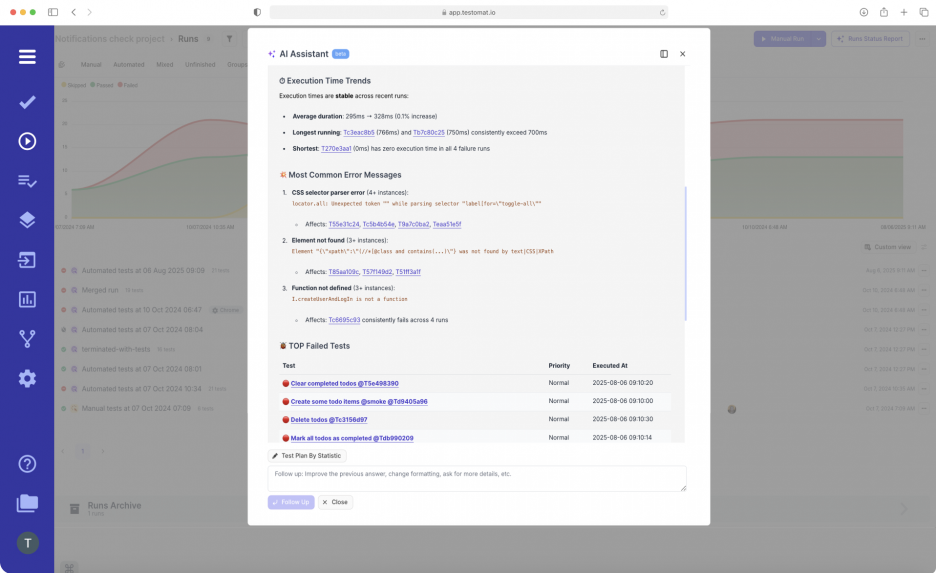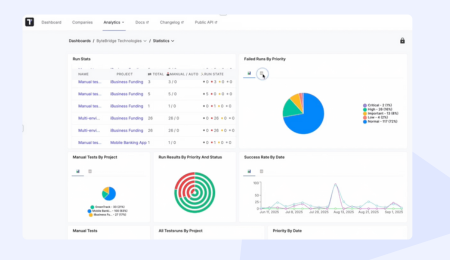
Nowadays, AI redefine how teams leverage test data in the software development lifecycle. AI-reporting is a key priority for the Testomat.io team. AI can easily generate an instant, human-readable summary of current testing progress and quality. It helps QA teams and stakeholders understand what’s working well and where attention is needed — without having to dig through individual test logs.
The Project Runs Status Report gives a quick overview of test stability, critical issues, and performance trends across recent runs.
What’s the AI Runs Status Project Report include?
- Summary overview – shows total test runs, overall pass rate, trends, and key action items.
- Area-specific stability – performance insights grouped by feature areas (e.g. subscriptions, user roles, etc.).
- Flaky and failed tests – highlights of recurring issues or flaky behavior with potential risk.
- Execution time trends represent how test durations are behaving over time.
- Top errors – it is the most frequent failure messages to help speed up debugging.
- Systematic failures – this refers to the list of test cases that consistently fail and may block critical flows.
- Notes – it is also a type of run analysis based on the latest project run information.
- Coverage clarity – compares the run with previous executions, spotting regressions or recurring problems.
Project Runs Status AI Report: How to generate it?
Project Runs Status AI Report is an intelligent feature built into the Run History Dashboard. Also, it is presented as an AI-powered Agent Assistant. So, to generate an AI-driven Project Run Report, easily with the button Run Status Report in the upper right-hand corner. Wait for… a few seconds, and the result should appear with an AI overview. Having examined it, since it is an agent, you can ask some additional questions in the chat window to receive enhanced feedback or deepen the report to the level you need by supplementing it with context information, customizing your report more.
For instance, prompt use cases:
- “Provides a high-level snapshot for stakeholders, highlighting overall health and critical issues”.
- “Create a detailed Runs Status Project Report for covering all test runs from September 1 to September 30, 2025. Include metrics such as test coverage, flaky test rate, and regression trends, with visualizations and recommendations for improvements.”.
In the first case, you can get the project failure rate across runs and identify critical failure patterns.
In the second case, you can get project health insights with critical Regression Risks section with recommendation of what worth to do.
If you are not satisfied with the results, you can easily regenerate them using the Regenerate button. These results are saved as an insight, in case you want to compare output results later. Share this AI testing report with stakeholders during the coordination of releases.
What is the difference between Test Management AI Reports?
In essence, the Runs Status Project Report is a snapshot tool for “what happened,” while the Deep Analyze Agent is an intelligent layer for “what to do next.” Project Runs Status AI Report aggregates information of the last 6 project runs. Run Summary Report of 1 test run – you can evaluate the whole project and only a particular Run. All of them enhance Testomat.io’s AI orchestration, but combining them yields the most value for agile teams. For more details, check Testomat.io’s docs on run reports or AI-powered test management functionality.
Why AI reports valuable for development teams?
Why AI reports valuable for development teams?
→ Saves time for testers and QA leads by skipping manual report writing.
→ Makes reports easier to understand for non-technical stakeholders (PMs, managers, clients).
→ Provides a common single source of truth after every run, keeping everyone aligned.
→ AI-generated reports also might be a source for compliance, audits, or historical tracking of project quality.
In short, the Project Runs Status Report transforms raw execution data into a clear, human-readable story about the project’s quality and stability, making it a cornerstone for efficient Quality Assurance and release management.
